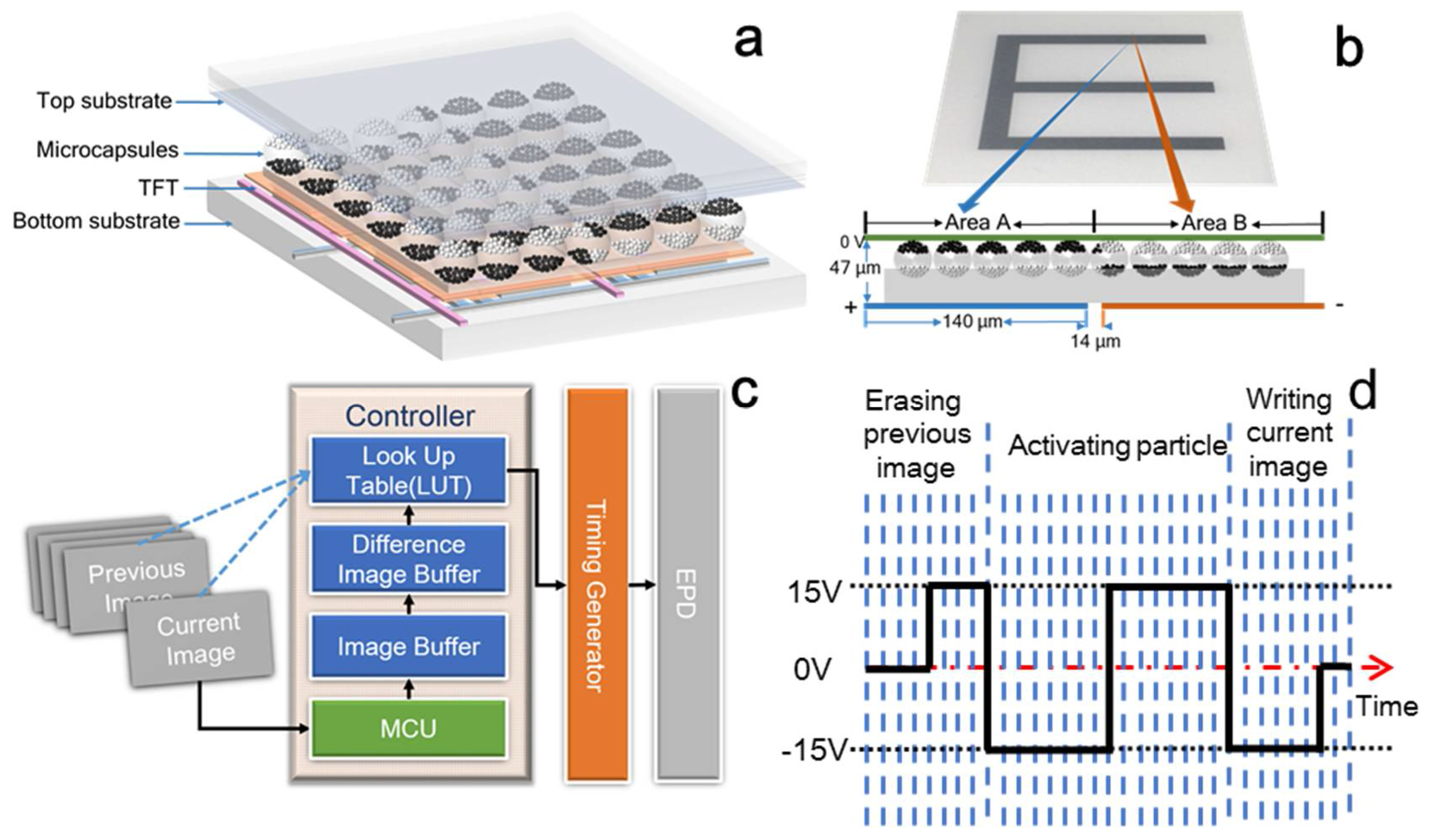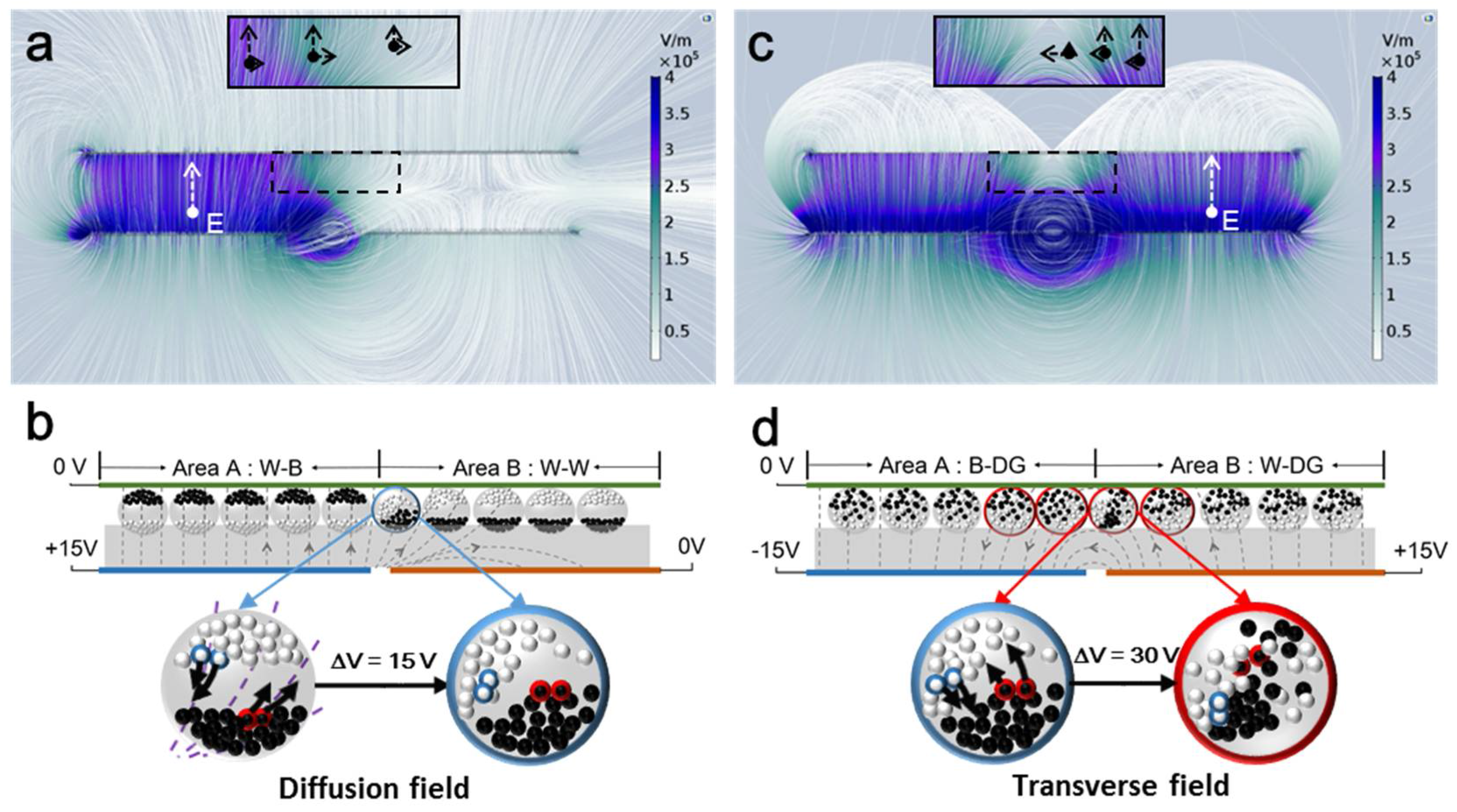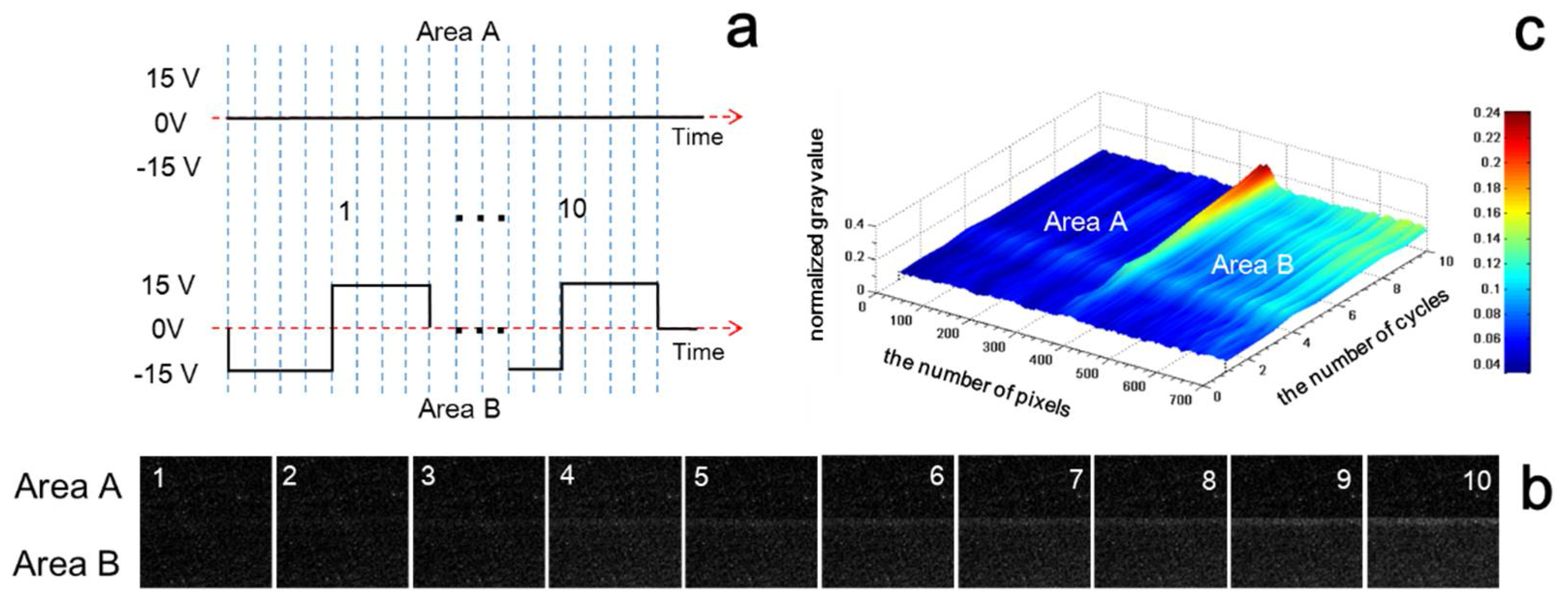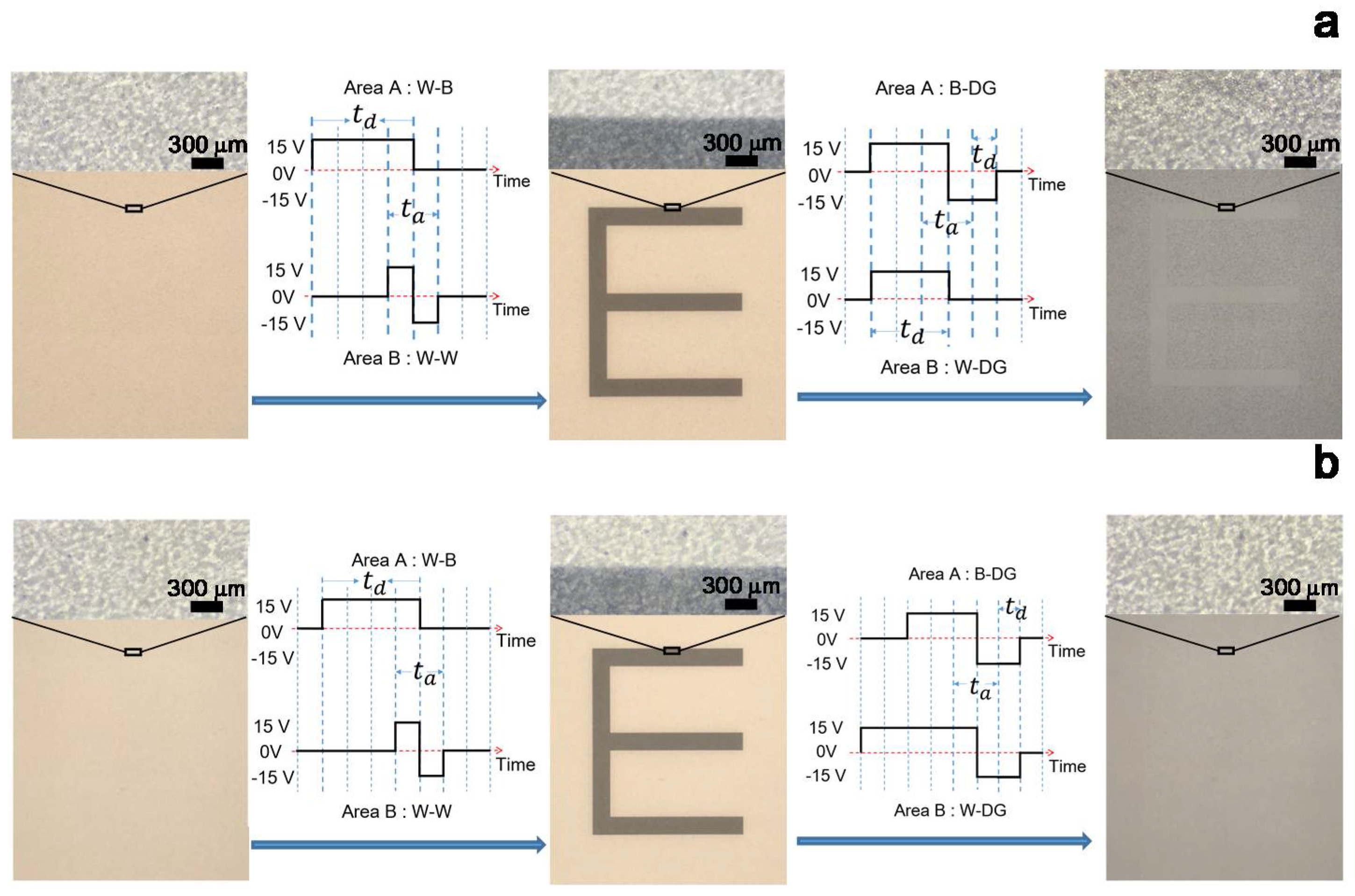3.1. Process of the Fringe Phenomenon on EPDs
The fringe phenomenon typically occurs as a boundary line between two different graytones, with distinguishing gray difference compared to the gray level of the left and right sides. Thus, it is typically viewed as contour lines of ghost images. When the value of gray difference is positive, a white line can be observed around the edges; and correspondingly, a black line occurs at a negative gray difference. When a driving waveform is applied, this phenomenon is commonly observed by a short driving process with a straightforward driving scheme which has also been reported by Kao et al. [
18].
In this work, the fringe phenomena were observed at various waveforms. A typical generating process of the fringe phenomena is illustrated in
Figure 2. The flow process from
Figure 2a–c represents a refreshing from a white background to an absolute black “E”, with
Figure 2b showing the corresponding driving waveform. Ideally, the refreshing process from
Figure 2c–e represents the image changes from the black “E” to a dark gray (DG) of the entire screen by using the waveform in
Figure 2d. However, a white contour is generated at the edges of “E” where the previous white background and the black “E” are located. This fringe phenomenon worsens the ghost image problem of EPDs.
At the first stage, from the original white background to the black “E”, Areas A and B were designed to drive electrophoretic particles to show W-B and W-W, respectively. Within 120 ms duration, the black Area A and white Area B appeared on the EPD screen. The diffusion field here is defined as shown in
Figure 2b, representing the electric field generated in Area A diffusing toward the region in Area B. By applying the second stage waveform (
Figure 2d), the change of Area A from B to DG and Area B from W to DG were obtained (
Figure 2e). When a 30 V voltage difference was produced between Areas A and B, within 60 ms continuous driving time, the transverse field was generated (
Figure 2d). Substantial horizontal components were generated because of the −15 V voltage on Area A and the +15 V voltage on Area B.
The cause of the fringe phenomenon is then analyzed and discussed as follows. In our experiments, we discovered that the fringe phenomenon appeared at the border of two different graytones such as the ghost image of the letter “E” with the gray value difference of 25.5 between contour and adjacent areas, as shown in
Figure 2e. Such a fringe phenomenon is significantly different from typical crosstalk which happens as undesired vertical or horizontal communication due to parasitical capacitances between the source line and the pixel electrode or the common electrode. In fact, the fringe phenomenon that resulted from the interference between adjacent pixels will be affected by the fringing field. Moreover, once the horizontal component of the fringing field drives charged particles to move in a horizontal direction, it will be difficult to restore the particle distribution by its own vertical driving electric field. A fringe phenomenon then remains on the screen for subsequent frames, reducing the display quality. Thus, deeply understanding the fringe phenomenon and diminishing it by waveform design are very important for the electrophoretic particle manipulation in EPDs.
The pixel electrode and common electrode in a pixel of EPD is equivalent to a parallel plate capacitance. Charges will aggregate on the surface of a rectangle pixel electrode with higher charge density at the four corners [
22]. The charge density at the node (
x,
y,
z) of a pixel electrode is calculated as Equation (2):
with
M (
x,
y,
z), a node on arbitrary plate of capacitance;
dS1 (
x′,
y′,
z′) and
dS2 (
x″,
y″,
z″), the area element on the upper plate and lower plate, respectively;
R1, the distance between
M and the node (
x′,
y′,
z′); and
R2, the distance between
M and the node (
x″,
y″,
z″).
ε is the permittivity for the capacitance.
V0 is the potential difference between two plates.
σ (
x,
y,
z) is the charge density of the plate.
As the surface charge distribution is inhomogeneous on the plate, the electric field around the plate’s boundary extends to the exterior area and therefore, generates the fringing field. Such an obvious effect cannot be neglected when analyzing the relationship between applied voltages on plates and the movement of particles.
To understand the relationship between the fringing field and voltage applied on a pixel electrode, the electric field between two pixel areas was simulated using COMSOL Multiphysics 5.3. As shown in
Figure 3, the horizontal component of the fringing field is found between two pixel areas, and the interior of the pixels as well. Therefore, the edge line is in fact widened. In the simulation, the side length of pixel electrode was set to 140 μm, the applied voltage on common electrode was 0 V. The distance between the common electrode and pixel electrode (cell gap) was 47 μm. The length and width of the common electrode were 294 μm and 140 μm, respectively. The inter-pixel gap between Areas A and B was 14 μm. The set of Maxwell equation is formulated as:
where
E is the electric field,
V is the potential,
ρv is the volumetric free charge density in the electric plates.
εr is the permittivity. The generated diffusion field is shown in
Figure 3a when the applied voltage on the pixel electrodes of Areas A and B are 15 V and 0 V, respectively. The magnified area was marked with black outline shows that diffusion field strength was reduced from approximately 3.5 × 10
5 V/m to 0.5 × 10
5 V/m. The vertical component of the diffusion field near to the inter-pixel gap and upper plate gradually diminished from Area A to Area B. The horizontal component remained in this magnified area. Corresponding particle distribution is shown in
Figure 3b under the effect of the diffusion field. It is clearly seen that the microcapsules in Area B and near the gap was significantly affected by the diffusion field. Particles distributed in the microcapsule marked as blue moved both in vertical and horizontal directions in the diffusion field. It should be noted that, at this stage, the fringe phenomenon might not appear because a large number of white particles in blue microcapsule are still on the upper surface with little difference compared to the white background.
When a 30 V voltage difference in the horizontal direction was applied as the designed waveform with −15 V and +15 V on pixel electrodes of Areas A and B, respectively. An obvious fringe phenomenon was observed, as shown in
Figure 3c, and the corresponding particle distribution is presented in
Figure 3d. The microcapsules near the gap are significantly affected by the transverse field, marked as four red microcapsules. In this situation, the fringe phenomenon is wider than the common electrode gap, and becomes more obvious. In this analysis, the focus area is from the common electrode to the position of 19 μm below, containing most microcapsules in an EPD device, called effective area. It is certain that the electric intensity of both diffusion and transverse fields in this effective area is less than the average electric intensity in the pixel area. The horizontal component of the fringing field in the effective area can change particle distribution which might be difficult to restore by a general vertical driving scheme, and thus, would remain for the long term. The vertical component of the fringing field in the effective area is insufficient to drive particles to reach the goal gray level. Therefore, in the process from W to DG, the fringe phenomenon will be demonstrated as a white line lying on the DG background.
3.2. Diminish Fringe Phenomenon by Optimizing Driving Waveform
From the simulated results as shown above, it is clear that once the transverse field is generated, it will induce undesirable particle distribution in the horizontal direction and weaker particle movement in the vertical direction. Both effects are detrimental to the realization of target gray levels. These make the fringe phenomenon even more severe than that from the diffusion field. Therefore, to eliminate the influence of the fringing field, we can highly improve the EPD displaying performance.
In this work, we propose and verify a method to diminish fringe phenomena via optimizing the electric driving waveforms. As shown in
Figure 4, three experiments were carried out to investigate the influence degree of diffusion and transverse fields. The real images driven at different driving stages were captured using a CCD camera equipped on a stereomicroscope.
First, the driving scheme in
Figure 4a was used to find out the relationship between the diffusion field and fringe phenomenon by only applying ±15 V square waveform with 0.5 duty cycle and 160 ms periods on pixel electrodes of Area A, keeping pixel electrodes of Area B at 0 V.
Figure 4b shows the captured displayed pictures by applying the waveform ten times. Each picture was taken at the end of each waveform cycle. The gray scale transformation and gray value normalization were obtained using Matlab software. The picture in
Figure 4c was obtained by averaging the 10 pictures of
Figure 4b. The 10 columns correspond to 10 repetitive cycles, and 700 pixels were obtained from the captured images. The gray difference in this picture is larger than the initial state over time.
Secondly, the experimental driving scheme of the transverse field was carried out in a similar way. Square waveforms of ±15 V with 0.5 duty cycle and 160 ms periods were applied on the pixel electrodes of Areas A and B, respectively; however, the directions of the applied voltages were opposite (
Figure 4d). Here,
te is the phase at the end of the designed waveforms, which is applied to ensure that both Areas A and B turn black at each driving cycle. In this way, the edge effect can be viewed clearly. Without the
te phase, during the driving scheme of the transverse field, when Area B turns black, Area A turns white. With the application of the
te phase, both Areas A and B can be driven to the similar states of black.
Figure 4e,f present the obvious fringe phenomena resulting from the transverse field driving process. Comparing
Figure 4c–f, it is obvious that the transverse field is more effective than diffusion field considering the generation of fringe phenomenon. Therefore, high voltage difference between adjacent pixels should be avoided to diminish the transverse field generation.
Accordingly, a method to reduce the influence of both transverse and diffusion fields was proposed and verified. The activating scheme was designed based on synchronously driving particles in adjacent pixels. The square waveform with 0.5 duty cycle and 160 ms periods was synchronously applied to the pixel electrodes of Areas A and B (
Figure 4g). The obtained results are shown in
Figure 4h,i. The initial image for this experiment was produced by repeating the diffusion field driving scheme 10 times. After four activating cycles, the fringe phenomenon was obviously lower; and the line induced by the fringe phenomenon completely disappeared after 10 cycles.
These results show that the fringe phenomenon can be clearly reduced by optimizing the driving waveforms. Conventionally, when +15 and −15 V voltages are applied on the pixel electrodes of Areas A and B, respectively, the gray scales are refreshed toward the opposite direction. However, an obvious transverse field would appear and induce obvious fringe phenomena. In our strategy, 0 V voltage is applied to Area B to generate a 15 V voltage difference to avoid the transverse field. In addition, in order to reduce the effect of the diffusion field, the activating driving scheme shown in
Figure 4g was designed to achieve the improved image quality in
Figure 4h. In EPD devices, the activating driving scheme is designed with the same voltage sequence of each waveform so that the particles near the line edges are remixed well. These particles are usually affected by an uneven electric field in the vertical direction near to the line edges. The activating scheme for remixing particles in vertical direction can reduce the difference of gray values in adjacent areas. Meanwhile, the synchronized motion of particles can reduce the effect of horizontal electric field in adjacent areas, thereby reducing the fringe phenomenon.
In order to verify the mechanism by which optimization of the driving waveform can improve the displaying quality of real images, a driving scheme was applied to the display and a black “E” was erased on an EPD device. The optimized driving waveform is shown in
Figure 5a. This driving waveform was verified as the same refreshing process as shown in
Figure 2. To achieve the goal gray levels, the straightforward driving phase is denoted as
td. The activating driving phase
ta aims to weaken the interference of the diffusion field, 40 ms was selected to be twice of the unit time period of waveforms (20 ms) without scarifying the straightforward driving time
td. To avoid producing the transverse field, the applied voltage is positive and negative before and after
ta phase, respectively. Therefore,
ta phase is in the middle stage of the optimized waveform rather than at the beginning of the waveform, which is shown in
Figure 2. At
ta stage, the applied voltage needs to be in a sequence from positive to negative from the front to the back. Comparing with the
td phase in
Figure 2d, the
td phase of the waveform for B-DG shown in
Figure 5a has been delayed for 40 ms to avoid high voltage difference in the
td phase of W-DG. We have tried various waveforms with fixed driving time of 160 ms. The result with
ta = 40 ms,
td(+) = 80 ms,
td(−) = 0 ms demonstrates the best displaying performance in diminishing the fringing effect in the W-B and W-W refreshing processes. The longest driving time of this driving waveform is 160 ms because the realization of the longest refreshing process of W-B (+15 V) and B-W (−15 V) will cost 80 ms, respectively. In order to reduce the driving time and keep the gray value constant, the time integral of voltage was kept constant with +15 V for 80 ms in
Figure 5a (W-B), and −15 V for 20 ms and +15 V for 100 ms in
Figure 2b (W-B), respectively. In general, the voltage at the end of the waveform contributes more to the gray value. Thus, +15 V for 40 ms was added in the front of the waveform for B-DG (
Figure 5a) to offset
ta in
Figure 2b (W-B) to obtain the waveform for B-DG in
Figure 5a.
The initial idea for designing waveforms for a bistable property is simply applying zero voltage when pixels remain at the same state like the pixels in Area B of
Figure 2b and
Figure 5a. The waveform in
Figure 2b can remain the W-W state with 0 voltage. However, such a scheme will make the next step activation more difficult according to the inactivated particles. Therefore, the
ta phase is added to the waveform in
Figure 5a for W-W. By using this optimizing driving waveform, the image ghost contours can be completely erased without changing the EPD structure or materials for the same period of driving time. Comparing
Figure 5a to
Figure 2e, the gray value difference was clearly reduced from 25.5 to ~0 (undetectable).
In
Figure 5a, the letter “E” is still distinguishable from the DG background according to its low evenness of gray scale. To further improve the image quality, a combined driving scheme aiming at homogenizing the gray scale was added, as shown in
Figure 5b. It was found experimentally that the uniformity of particle distribution obtained by using the refreshing process from black toward gray was better than that from white toward gray. The mechanism for this has not yet been fully understood. The waveforms for W-DG in
Figure 5a,b are significantly different for optimizing the low evenness of gray scale. The waveform in
Figure 5a drives the pixel from white to target DG directly. In our experiments, we found that the black particles move quickly to form ring structures in the microcapsules when driven directly from white to DG. Therefore, the obtained DG stage is not very uniform. In
Figure 5b, the waveform drives the pixel at two stages, from white to black and from black to target DG. Therefore, better uniformity could be achieved. Such a gray scale homogenizing driving scheme is well integrated with eliminating fringe phenomenon scheme. The kernel of the homogenizing scheme is to improve the uniformity of the white and black particle distribution near the upper plate. It costs 100 ms to obtain a uniform dark situation as an initial state. Accordingly, the longest driving time (or refreshing time) was 200 ms, considering each W→B and B→W refreshing processes costs 100 ms. As seen from
Figure 5b, the ghost image is completely eliminated by this optimized driving waveform.









